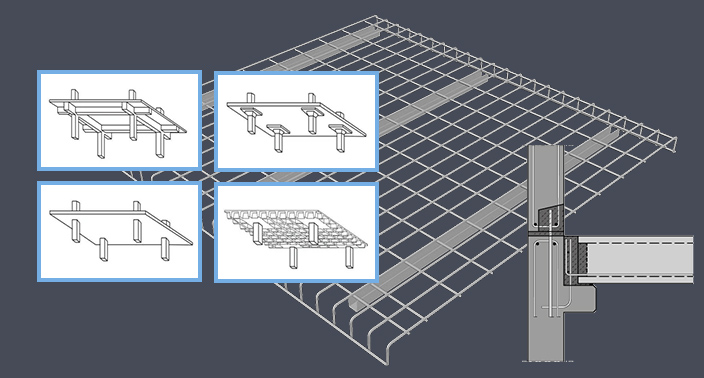Welcome to Skytree!

Analysis and Design of Two-Way Post Tension Slabs
The construction of slabs provides flat surfaces, usually horizontal in building floors, roofs, bridges, and structure types. Post-tension (PT) slab formation occurs through an amalgamation of conventional slab reinforcement and additional protruding high-strength steel tendons subjected to simultaneous pressure.PT slabs containing concrete, tested and subjected to compression, form the thinnest slab types and have a longer span with spaces free of columns. PT Slabs exhibit huge strength and can carry loads due to the presence of steel and high compressive strength.
Analysis of Two-Way Slab System
The two-way slab is a slab that gets supported by beams on all four sides, and the loads are carried by the supports along with both directions. The ratio of longer span to shorter span in two-way slab is less than 2.
We provide main reinforcement in both directions as bending occurs in both directions. Loads get carried in both directions in two-way slabs.
Two-way slabs get used in all types of buildings, such as parking structures, hotels, office buildings, and apartments.
Columns in these slabs are mostly rectangular patterns with around a 2:1 ratio between sides. These columns get designed primarily for axial load and minimal moment transfer due to slab stiffness.
These slabs do not have continuous support like long beams and walls. They are best to resist uniform-type loading as large point loading is challenging to resist.
A two-way PT slab system consists of ducts, tendons, and anchors. Ducts get made from thin metal sheet pipes consisting of screw coupling and Tendons prepared by a protective coating of one or more steel pieces and placed within sheathing or duct. Anchors work to fix the tendons to the concrete.
Design of Two-Way PT Slabs
The design of two-way PT slabs for any building should initiate with conducting load analysis and load effects at different parts of the building, such as framing dead load, superimposed dead load, and live loads. We should determine the preliminary slab thickness and weight of rebar materials like concrete, rebar, and unbonded tendons. Design steps of Two-way PT slabs include:Jacking Stage
At the Jacking stage, a temporary force (with maximum prestress force) gets exerted by the device introducing tension into the prestressing environment. At the time of jacking, allowable stress, i.e., compression and tension, should get followed according to Class U (ACI 18.4.1).
Transfer Stage
After the jacking stage, we need to identify the activity of the anchorage device, tension force loss due to friction, and tension loss due to elastic shrinkage of concrete.
We need to check the loading condition of the slab using prestress force, Fsi (before short/long-term tension loss occurs, Max. prestress), and concrete strength, Fci (compressive strength of concrete when prestress gets introduced, Min. strength).
The load applied is only self-weighted before adding a finishing and live load. We need to check if there is any tensile cracking and crushing of concrete or failure of the anchorage part.
Service Stage
After the transfer stage, identify if there is any tension loss due to creep, tension loss due to shrinkage, and due strand relaxation.
We need to use prestress force, Fse (Effective tension after short/long-term tension loss occurs), concrete strength, Fck (Max. design strength), and loads applied are all design loads, i.e., unfactored loads. Identify deflection and crack width.
Ultimate Stage
At the ultimate stage, the loading conditions are: use of prestress force with nominal strength and concrete strength with maximum design strength, and the loads applied are all factored design loads. We need to check flexural failure or compression stress under flexural behavior.
Design Two-Way PT Slab with Skytree

Skytree is a leading engineering company that provides PT design services for various projects, from health hospitals, hotels, high-rise buildings, and other complex structures. The organization indulges one-way and two-way PT slab design, waffle slabs, beams, joists, etc. The two-way slab designed at Skytree gets customized to the building and project requirements, followed by thorough analysis, 3D BIM modeling, and design.

Get in Touch
You will find yourself working in a true partnership that results in an incredible experience and an end product that is the best.
Call us on
+91 80 4145 4670
Email us
info@skytreeconsulting.com
